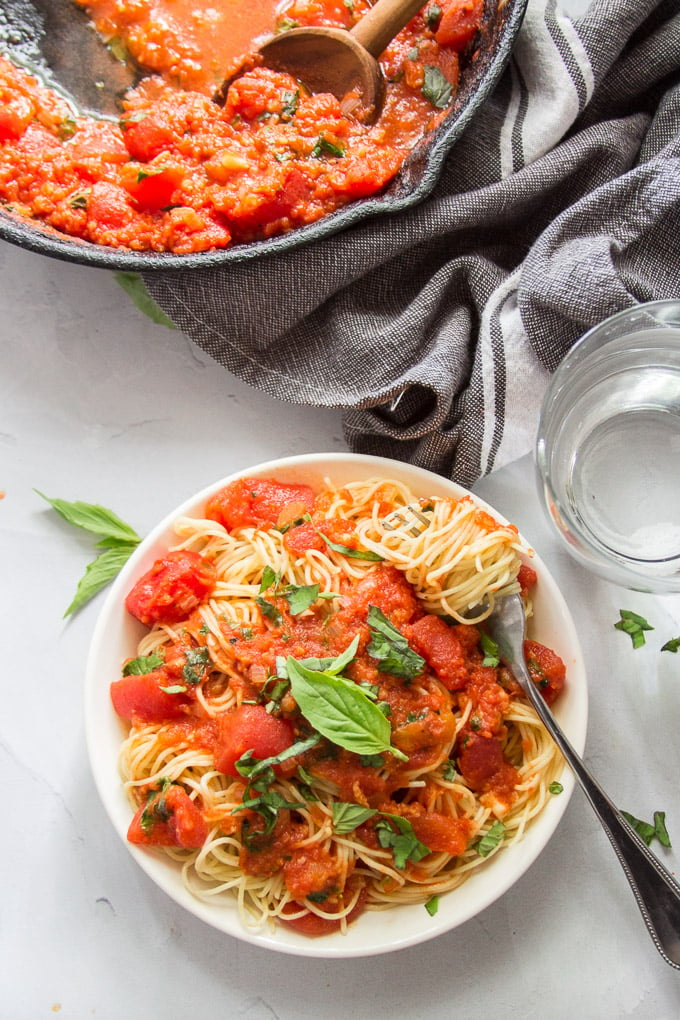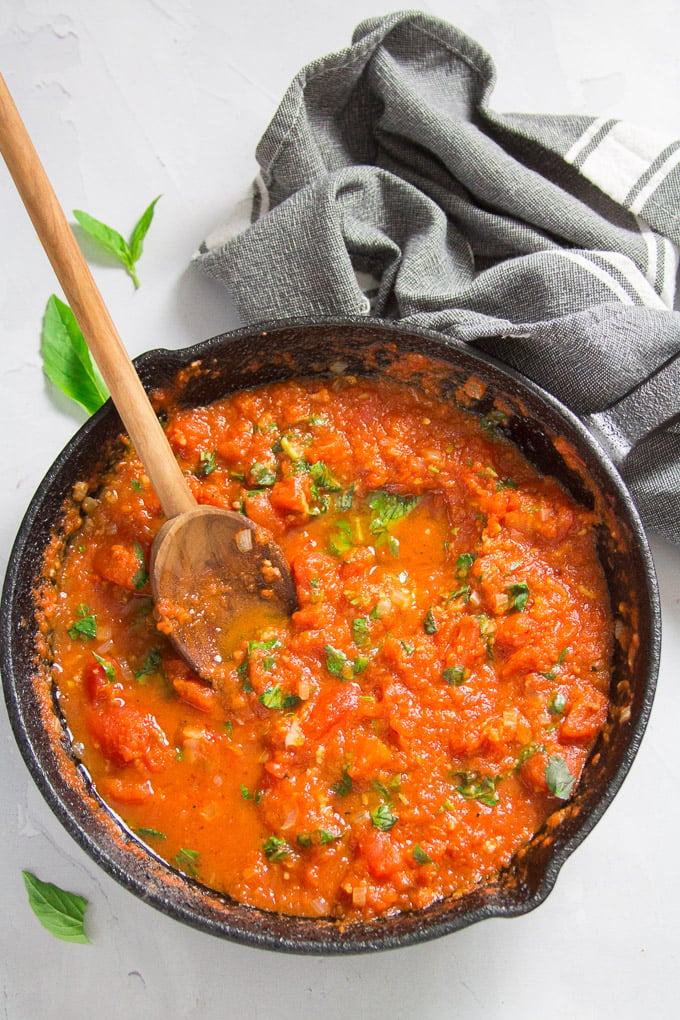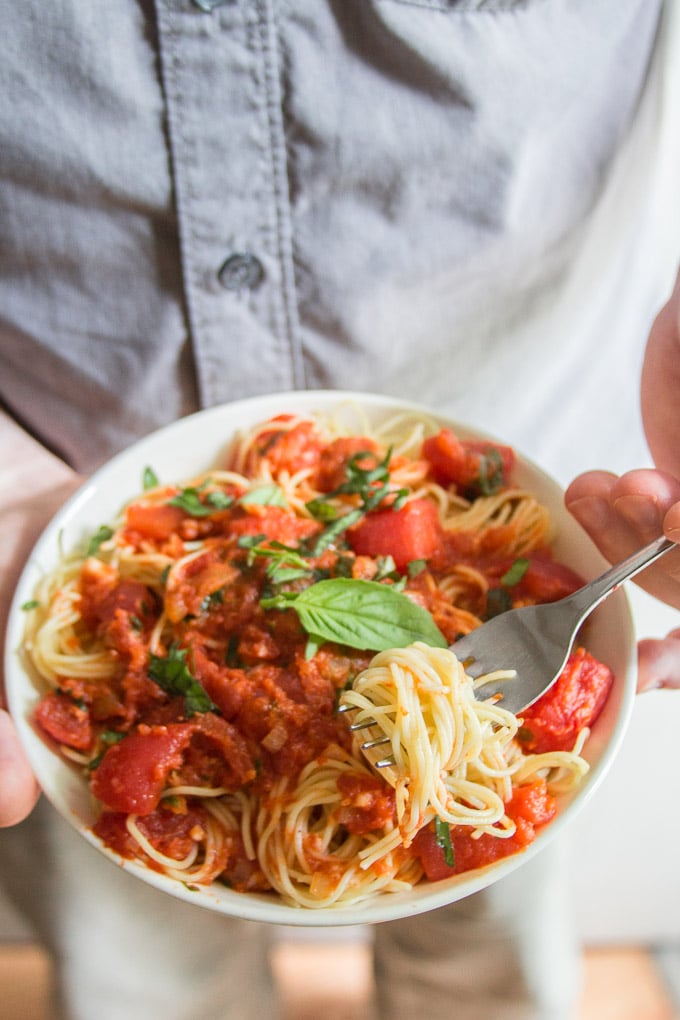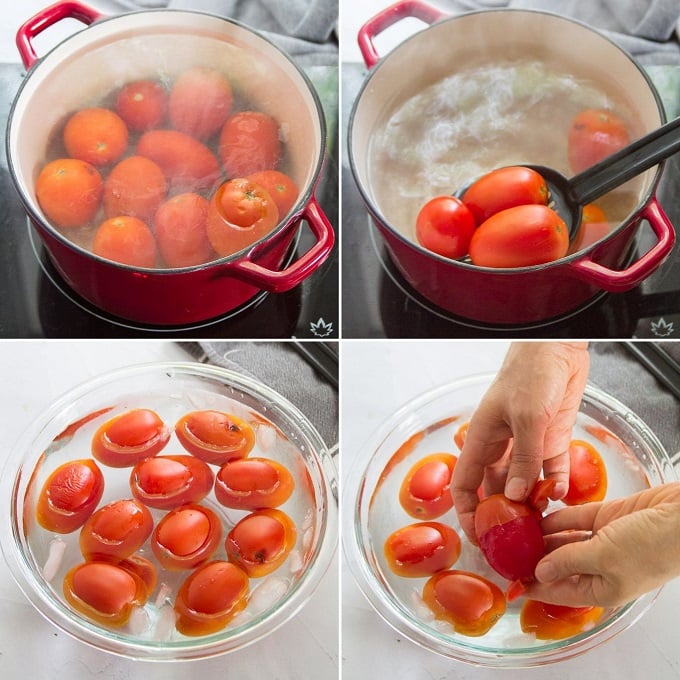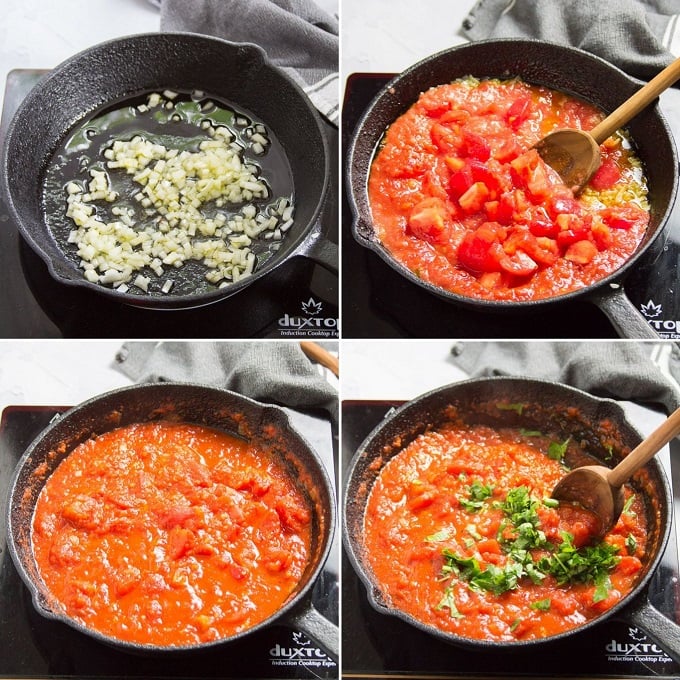Usually I suck pretty bad as a vegetable gardener, but this year I lucked out! My garden is overflowing! And the funny thing is, in past years I’ve gone to fancy little garden shops and bought what they told me were the best vegetable plants, only to have them barely give me any veggies — and the ones that I did get didn’t even taste very good. This year I thought I was halfway throwing in towel by buying any old cheap vegetable plants from the local hardware store. But to my surprise, I’m overrun with fresh herbs, kale, peppers and tomatoes. Especially tomatoes. I’ve been going out to harvest tomatoes about every other day and getting a bucket full every time. Time to make some pasta pomodoro!
What is Pomodoro Sauce?
The simple explanation is that it’s tomato sauce. At least that’s what they told me when I waited tables at an Italian chain restaurant. But there are a bunch of different kinds of tomato sauces! Where marinara sauce is notable for its smooth texture and zesty flavor, and arrabbiata is known for its heat, pomodoro sauce is a light and chunky tomato sauce, made with minimal ingredients, and seasoned with garlic and basil. It’s perfect for summer and great for using up those fresh tomatoes! “But do I have to use fresh tomatoes?” you may be asking. Nope! You can use canned if you prefer. Using fresh is a bit of extra work, and good quality fresh tomatoes aren’t usually available year round. So feel free to substitute canned if you prefer — I’ve included some notes in the recipe on how to do that.
The Best Tomatoes to Use for Pomodoro Sauce
Plum tomatoes are preferable for making pomodoro sauce, since they have fewer seeds than other varieties. If you want to substitute another variety you’ll probably need to dedicate some time to removing the seeds, and you’ll also need to use some extra tomatoes to make up for the volume lost by discarding the seeds.
How to Make Pasta Pomodoro
First, cook your pasta and toss it with some olive oil. I really like capellini with pomodoro sauce, but use what you like! If you’re using fresh tomatoes, you’ll want to peel them first. Confession: I’m always tempted to skip peeling them. If you’re like me, resist. Peel those tomatoes! Otherwise you’ll have bits of peel in your sauce, which totally messes with the texture and can add some bitterness. To do this, bring a big pot of water to a boil. Add your tomatoes, in batches if needed, and blanch them for about 30 seconds. Remove the tomatoes with a slotted spoon and transfer them to an ice water bath. Let them sit in the bath for a few minutes to cool down. Next, grab a tomato from the bath. The skin should peel off pretty easily. Feel free to cut a little slit in the skin with a knife to get it started if you need to.
Now you’re ready to make the sauce. Prep your tomatoes by roughly chopping them up. If you’re using plum tomatoes you shouldn’t have too many seeds to remove. Use a finger to scoop out any large clumps of seeds, but don’t knock yourself out! Once they’re chopped, puree half of the tomatoes in a blender or food processor. Heat up some olive oil in a skillet. When the oil has had a minute to heat up, add the onion. Sweat the onion for about 5 minutes, until it softens up a bit. Add some garlic and let it cook for just about a minute. Next, add the tomatoes and a pinch of red pepper flakes. Heat up the sauce and bring it to a simmer. Let it simmer for about 15 minutes, until it thickens up just a bit. Take the skillet off of the heat, stir in some basil, and season your sauce with salt and pepper to taste.
Toss it with your pasta and serve!
Use good quality tomatoes for the best sauce! If tomatoes are out of season and you can’t get your hands on good ones, don’t even try to make it work. Just use canned! To substitute canned tomatoes, use one (15 ounce) can of diced tomatoes and one (15 ounce) can of crushed tomatoes. Skip step 12 of the recipe, which asks you to blend half of the tomatoes. If your sauce tastes very acidic, try few pinches of sugar. Also keep in mind that the sweeter your tomatoes are to start with, the less tart your sauce will be. Can this dish be made gluten-free? Yup! Just use your favorite gluten-free pasta. How to the leftovers keep? How are they best stored? I recommend storing the sauce and pasta separate, if at all possible. Store both components in sealed containers in the fridge, for up to 3 days. Reheat the sauce in the microwave or on the stove, adding a splash of water if needed. To reheat the pasta, boil some water and add the cooked pasta. Let it heat up for about 30 seconds, then drain it into a colander.
Like this recipe? If so, be sure to follow me on Facebook, Pinterest or Instagram, or subscribe to my newsletter. And please stop back and leave me a review and rating below if you make it!
